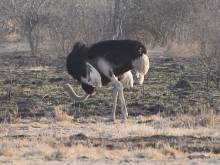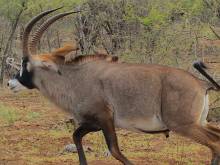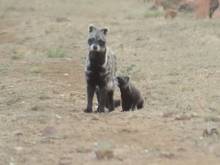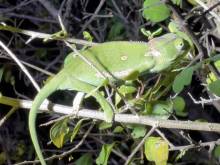Rhulani Minute Safari - The little Elephant and the tree
Elephants love the trees. They give them food and they provide shade on hot days. This little elephant here has a bit of trouble with this tree. No shade, no food. But at least he can scratch his butt a bit.
Read moreRhulani Insights 223 - Solar Panels
Once again a blog about our solar system. Today we’ll talk about a few technical details of the solar panels that intercept sunlight and generate electricity for Rhulani Safari Lodge. The panels have very special properties, as expert Kyle from Blockpower explains to us
Read moreRhulani Minute Safari - Something about the Ostrich wings
The large, feathery wings of the ostrich have many functions. Here we see the male walking slowly through the savannah, often stretching his wings to the side, which provides him with good ventilation. The beautiful color and size of the spread wings also help to impress the female.
Read moreAlasdair’s photos: What was that?
Rhulani’s rangers occasionally take a photo themselves on the daily game drives and put it on the shared dropbox of Rhulani so that we can use it for our social media. While looking through today we came across a photo taken by our head guide and “Captain Redbeard” Alasdair. What was that? Alasdair, please explain!
Read moreLife of a Ranger: Milkweed Locust
Did you know that the Milkweed Locust secretes a poison when attacked – for example - by a bird? Today Rhulani’s Ranger Dean tells us interesting details about one of his favorite animals, and he explains that brightly colored insects are often a warning of possible poisonous defense mechanisms.
Read moreRhulani Minute Safari - African Civet with a baby
Today we’re focusing our attention on a species that looks like a cat, but isn’t, and that we only rarely see: an African Civet. Here very close to the fence line we discover a mother with her baby. We are lucky to observe this animal in day light, because The African civet is primarily nocturnal and spends the day sleeping in dense vegetation.
Read moreRhulani Insights 222 – A Sausage Tree
In the entrance area of Rhulani there is a tree that attracts attention because of its large, long fruits. No surprise that this is called a “Sausage Tree.” But unlike real sausages, these tree fruits are pretty hard things. But let’s let Dean tell you more about it.
Read moreBrown Hyena – searched and found!
Most of the time on our daily safaris we just go out into the bush and are excited to see what we will find. However, sometimes it happens that we search for a very specific animal because it may be the only one that a group of guests has not yet found, or because of a specific request. Like this time. The target was a brown hyena. A real challenge! Such targeted expeditions are not always successful. But this time it was. Read the interesting story told by Willem.
Read moreRhulani Minute Safari - Flap-necked Chameleon
This small animal is hard to spot and is well camouflaged in the bushes. But because the flap-necked chameleon is a territorial animal, it can be found in the same bush every evening. And we are amazed that the Chameleon can adjust the color on the two sides differently depending on the lighting conditions.
Read moreLife of a Ranger: The horns of the Kudu male
Did you know that Kudu males live around eight years and that their long horns gain a curve every two years? Today Rhulani’s Ranger Willem tells us interesting details about the Kudu horns, and he mentions the white tip that appears as soon as maturity is reached.
Read more

















